Introduction
The Trail Designs “12-10” and Kojin, and the Zelph Starlyte and Starlyte “Mod” are four lightweight alcohol stoves of interest to our community. They are simple, lightweight, durable, low-cost, and functional designs.
With each of them weighing around 16 g (0.5 oz), the factors to consider in evaluating their performance include fuel consumption and boil time in a variety of environmental conditions. This review investigates and compares the performance of each stove.
Features and Specs
The following table presents a comparison of each stove model (scroll right to see all data if needed).
| Fuel Capacity | Batting? | Primer Pan? | Diameter | Height | Weight (claimed) | Weight (actual) | MSRP (USD) | |
|---|---|---|---|---|---|---|---|---|
| Trail Designs 12-10 | ~ 1 oz | no | yes | 3.25 in | 1.5 in | 16 g | 15.0 g | $11.95 |
| Trail Designs Kojin | ~ 1 oz | yes | no | 2.5 in | 0.8 in | 17 g | 16.1 g | $11.95 |
| Zelph Starlyte | ~ 1 oz | yes | no | 2.875 in | 1.25 in | 16.4 g* | 16.1 g | $12.00 |
| Zelph Starlyte Mod | ~ 1 oz | yes | no | 2.875 in | 1.25 in | n/a | 16.4 g | $13.00 |
* Manufacturer’s claimed weight includes a pot support, which isn’t needed for Caldera Cone use. Actual measured weight is reported for the stove without this pot support.
Batting
Three of the models contain fibrous material in the fuel chamber (“batting”). Some alcohol stove enthusiasts and manufacturers will also call this batting a “wick.” The purpose of this batting is:
- To reduce spillage of fuel in case the stove is knocked over, or during transport, if used in conjunction with a tight-fitting lid;
- To retain unburned fuel in a stove during storage/transport on a trip (requires a lid);
- To improve stove “performance” (by changing the fuel burn rate and temperature by regulating vaporization).
Caldera Cone
For comparison purposes, a Trail Designs Caldera Cone (Sidewinder Model) was used for all stove tests in this review. The Caldera Cone is designed to work as an integrated system with an alcohol stove and cooking pot. Caldera Cones are custom built to work with a particular model of cooking pot. For this review, a K-Mart (Stanco) Grease Pot was used in all tests.
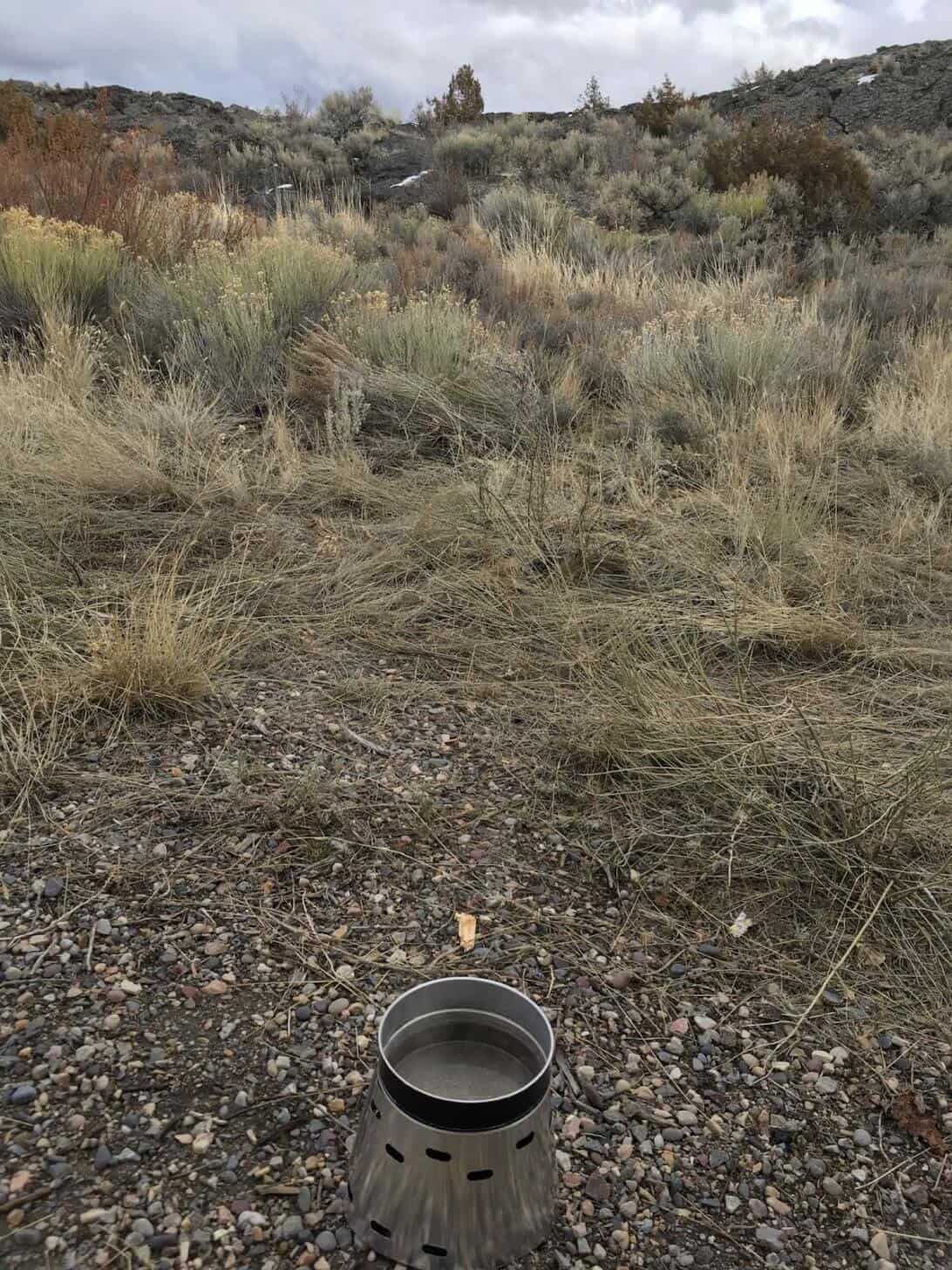
Trail Designs 12-10
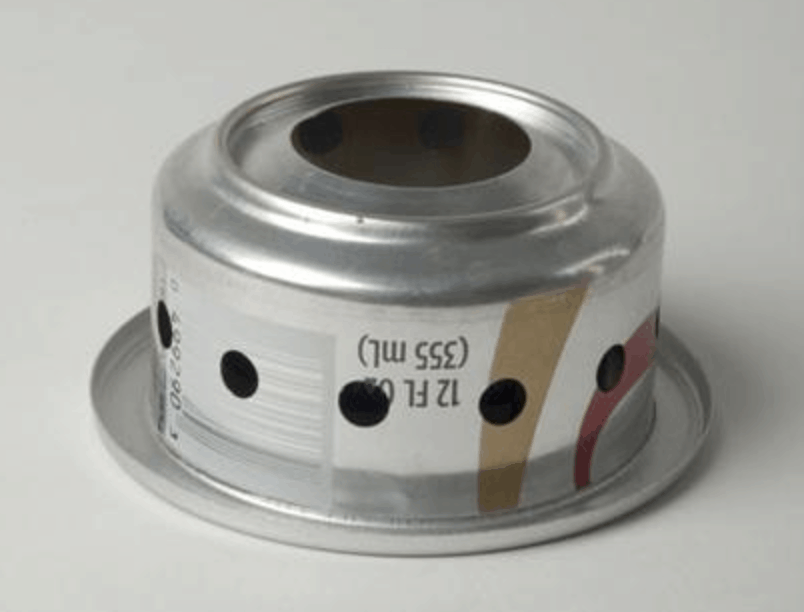
- Made of “upcycled” aluminum (repurposed soda cans);
- What’s unique: a simple, one-piece design.
Trail Designs Kojin

- Made using a lightweight aluminum screw-top container;
- What’s unique: A screw-top lid combined with interior batting; low height and small diameter make for a compact package.
Zelph Starlyte
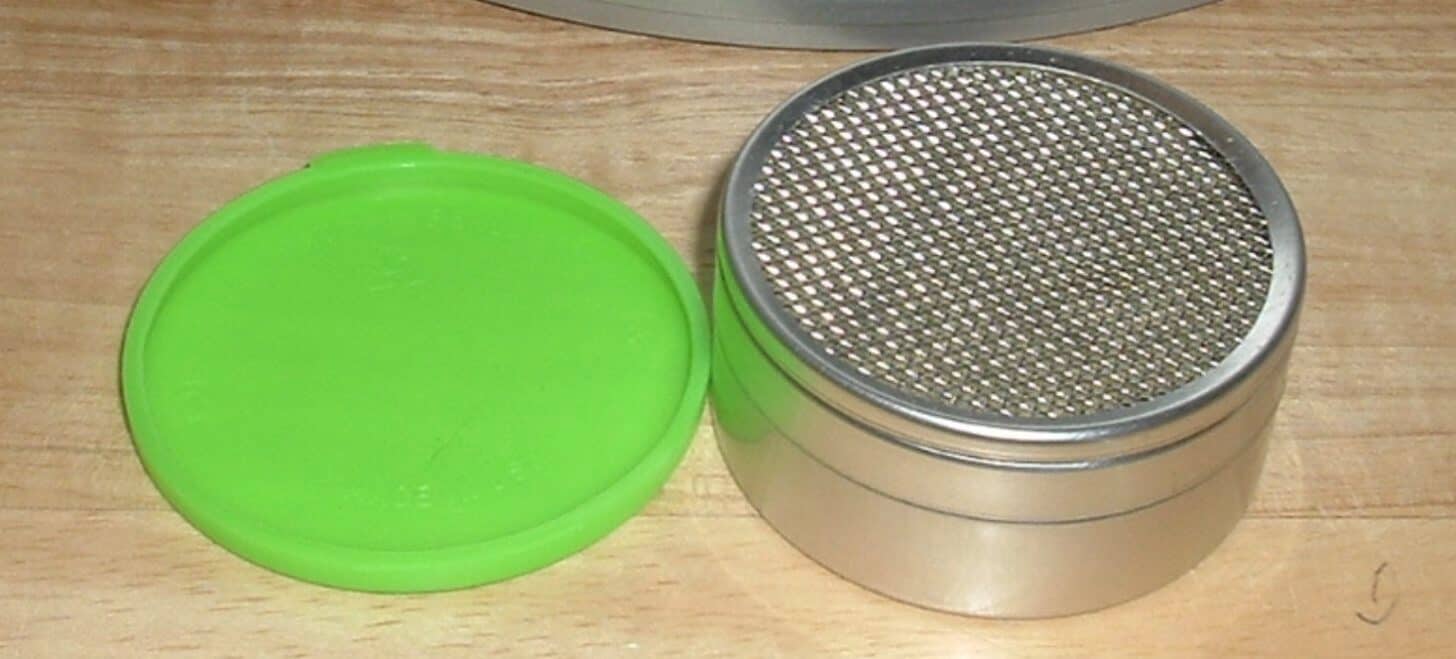
- Made using an aluminum container, plastic press-fit lid included;
- What’s unique: lid is made of plastic and fits very snug to secure any fuel left in the stove.
Zelph Starlyte Mod
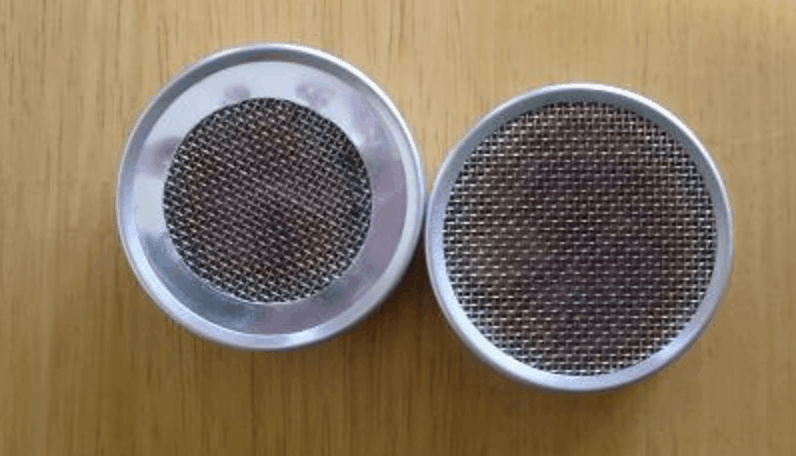
- Made using an aluminum container, plastic press-fit lid included;
- What’s unique: reduced burner surface area (relative to the unmodified Starlyte) to slow burn rate for better performance in cone-style systems.

Review Context
I began intentionally practicing ultralight backpacking only in the last two years; my body is less inclined to haul big loads over long miles or steep climbs. Over the past several months, I’ve been researching lighter cook kit options to replace my one-pound cook kit with something lighter and a bit more compact.
Last fall, I started researching and learning about alcohol stoves. I collected a bunch of cat food cans and made some with our Boy Scout troop. It was fun, easy, inexpensive and didn’t take a lot of time to make. However, I felt like after years of enthusiasts using and making stoves for ultralight cooking systems, someone would have thought of a better, more efficient design than something hacked out of a cat food can!
My goal was simple: which alcohol stove offered the best balance between boil time and fuel efficiency for boiling two cups of water? For my Scouts, I was also interested in burn and fire safety: a stove that would minimize the hazards of spills while cooking and filling.
Description of Testing
I performed some experiments to evaluate the performance of the alcohol stoves for this review. Each experiment used the same cook kit.
The Cook Kit: Each stove was used in a Caldera Sidewinder Solo cone combined with a K-Mart (Stanco) Grease Pot (5.6 in diameter x 4.0 in height, 32 oz capacity).
Ambient Air Temperature: Nature dictated the ambient temperature from experiment to experiment. However, each stove was tested at the same temperature during any single experiment. Ambient temperatures varied from 43 deg F (6 deg C) to 56 deg F (13 deg C).
Water Temperature: Starting water temperatures during all experiments was approximately 65 deg F (18 deg C).
Four experiments were performed:
- The Boil Control Experiment. This test is what it sounds like. In my wind-free garage (with an open door for ventilation), I tested the time required for each stove to boil two cups of water with the lid OFF. I filled each stove with 1 oz (28 g) of fuel and measured the weight before burning and after boiling to measure how much fuel was used to reach boiling point.
- Low Wind Experiment. This test was administered under the same conditions as the Boil Control Experiment but with the added variable of a low-speed fan used to generate an artificial breeze. The fan produced a constant wind of 2.5 mph directed to the cooking system from one side. The cook pot lid was ON during this experiment, although I also tried the experiment with no lid on the cook pot, none of the stoves were able to reach a boil.
- High Wind Experiment. This test worked the same as the Low Wind Experiment, but the wind speed was increased to 6.6 mph. The cook pot lid was ON during this experiment, although I also tried the experiment with no lid on the cook pot, none of the stoves were able to reach a boil.
- Outdoor Experiment. This test was conducted in the Hell’s Half Acre Lava field West of Idaho Falls. With constantly gusting winds in a climate so dry that it makes Idahoan potatoes famous, this was an ideal proving ground outside of the laboratory conditions of my garage. Even though the wind was frequently gusting up to 5.5 mph (8.9 kph), I was able to use rocks as a wind barrier so that the wind speed hitting the cooking system was effectively 0 mph. The cook pot lid was ON during this experiment, although I also tried the experiment with no lid on the cook pot, none of the stoves were able to reach a boil.

Performance Assessment
First of all, let me say that all of the stoves performed to my expectations for how an alcohol stove should perform (for my needs). This series of experiments essentially pits four well-performing stoves against each other to see if any one of them is clearly superior to the others.
Depending on the distance of a hike or how arduous a hike is planned to be, you may want to focus on pinching grams (whether as part of your cook kit or fuel requirements) where you can. That end objective is one of the goals of collecting stove performance data like this.
Raw Data
With that in mind, here is the raw data from my experiments (scroll right to view all data if needed):
| stove | test | weight (start) | weight (boil) | fuel used | boil time |
|---|---|---|---|---|---|
| 12-10 | boil control | 39.9 g | 19.1 g | 20.8 g | 10m 36s |
| Kojin | boil control | 45.1 g | 21.0 g | 24.1 g | 8m 29s |
| Starlyte | boil control | 36.8 g | 19.8 g | 17.0 g | 12m 35s |
| Starlyte Mod | boil control | 37.1 g | 16.2 g | 20.9 g | 17m 10s |
| 12-10 | low wind | 36.3 g | 19.4 g | 16.9 g | 11m 30s |
| Kojin | low wind | 30.3 g | 11.3 g | 19.0 g | 11m 29s |
| Starlyte | low wind | 36.0 g | 13.7 g | 22.3 g | 21m 31s |
| Starlyte Mod | low wind | 35.5 g | 15.2 g | 20.3 g | 17m 56s |
| 12-10 | high wind | 40.6 g | 19.0 g | 21.6 g | 16m 38s |
| Kojin | high wind | 33.8 g | 11.1 g | 22.7 g | 11m 57s |
| Starlyte | high wind | 34.5 g | 13.0 g | 21.5 g | n/a* |
| Starlyte Mod | high wind | 38.1 g | 18.1 g | 20.0 g | 19m 08s |
| 12-10 | outside | 40.6 g | 23.4 g | 17.2 g | 8m 03s |
| Kojin | outside | 32.9 g | 15.5 g | 17.4 g | 7m 34s |
| Starlyte | outside | 33.8 g | 17.5 g | 16.3 g | 10m 07s |
| Starlyte Mod | outside | 35.6 g | 15.5 g | 20.1 g | 15m 52s |
*The Starlyte struggled in high winds. At 16:38 or so the flame burned out, and the temperature of the water had only reached 184 deg F.
Comparison Results: Boil Control Test
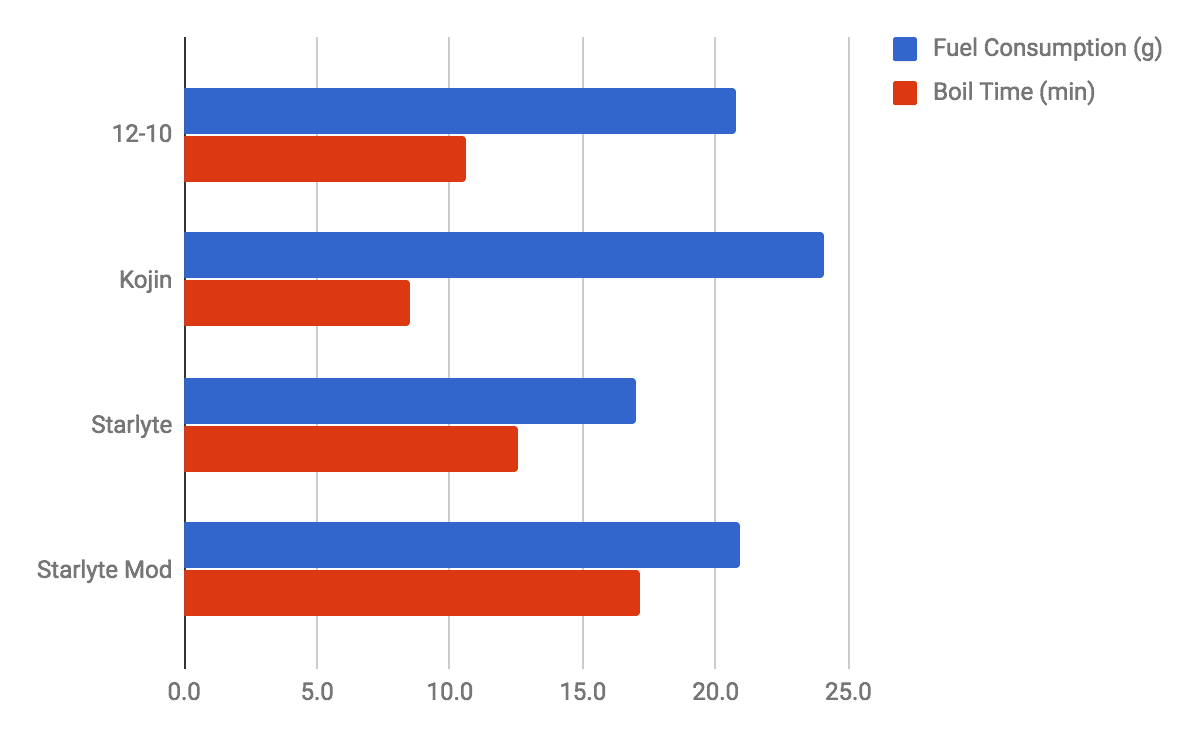
Observations:
- Most “powerful” stove: The Kojin was the most “powerful” stove – in that it boiled water the fastest, but consumed the highest amount of fuel to do it.
- Most “fuel-efficient” stove: The Starlyte was the most fuel-efficient stove in the test, but at the expense of boil time – it required more than four additional minutes to boil the water.
- Head-to-head: For similar amounts of fuel consumption, the 12-10 boiled water much faster than the Starlyte Mod.
Member Exclusive
A Premium or Unlimited Membership* is required to view the rest of this article.
* A Basic Membership is required to view Member Q&A events

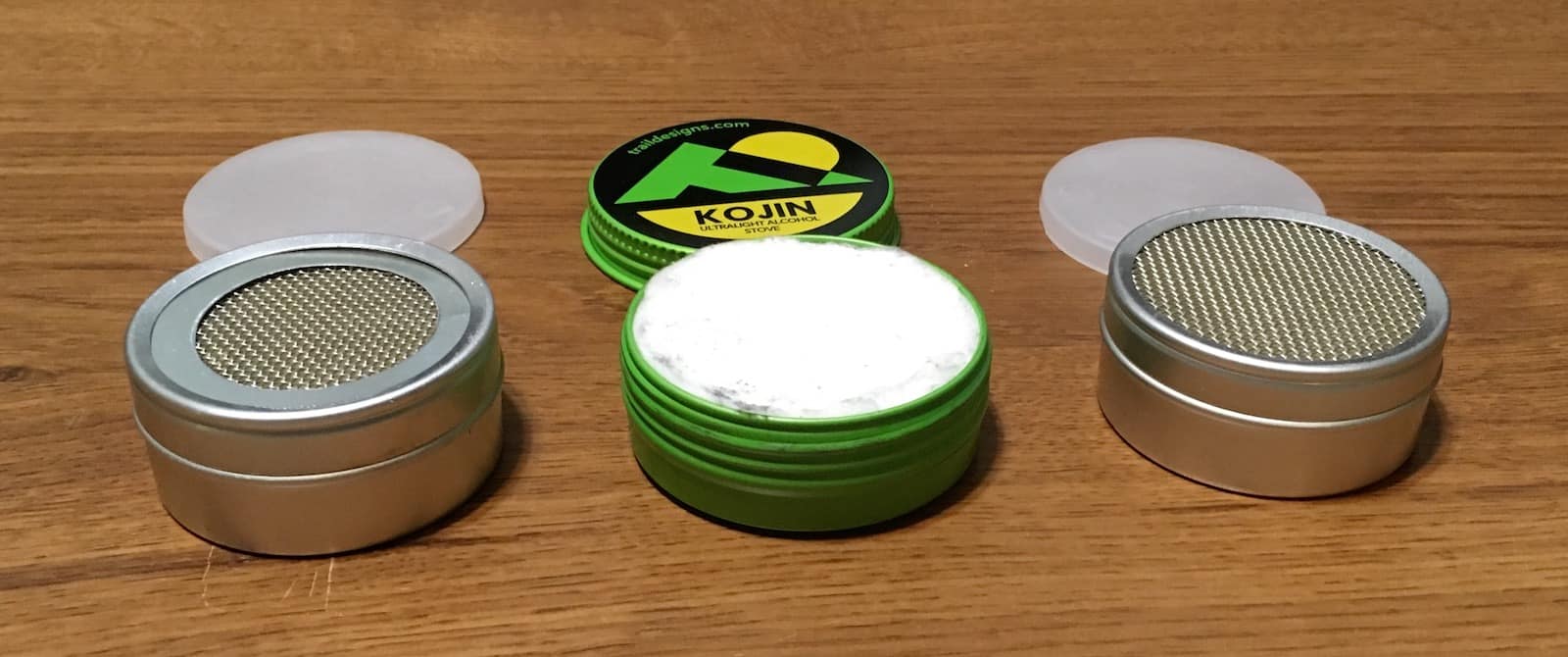
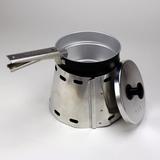


Home › Forums › Alcohol Stove Comparison: Trail Designs (12-10 and Kojin) vs. Zelph (Starlyte and Starlyte Mod)